KNOWN ERRATA
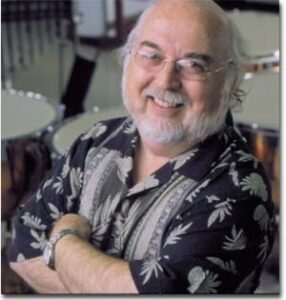
Hello Friends,
An undeniable fact of the publishing world is that, no matter how intensely one proofs a score, or meticulously transcribes music to the page, there will always be mistakes and inadvertent deletions.
An undeniable fact of the composition world is that, even though you’re sure of the interpretation you desired when you initially composed the piece, if you are a conductor also, invariably you discover attributes about the work while conducting that convince you to change some musical characteristics to better enhance the performance.
An undeniable fact of the instrumentation world is that, there are always new instruments being created, especially in the percussion world, and some are so exotic as to be difficult to locate in the average American band instrument shop.
This section of my web site will serve as an ongoing collection of errata discoveries (and solutions), interpretation changes I have made in my own music, and FAQ’s that pop up in my e-mail, some almost weekly.
Thank you for playing my music. I hope this site will help you.
****
IN THIS SECTION:
1. The “Afro Crasher / Crusher”
2. Otserf 2 – Errata
3. Gears, Pulleys, Chains – Percussion Needs
4. Til His Hand Grew Tired and Froze to the Sword – Errata
5. Adagio – Performance suggestions
6. The “Holsinger Style”
7. Liturgical Dances – Errata / Program Notes
8. On an American Spiritual – Errata
9. Prelude and Rondo – Errata
10. Scootin on Hardrock – Performance Notes
11. Abrams Pursuit – Errata
12. In Praise of Gentle Pioneers – Performance Notes
13. Hymnsong of Phillip Bliss (All Versions) – Expanded Program Notes
14. Havendance – Program Notes
15. The “Lion’s Roar” – Percussion Information
16. How do the “Hebrew” sounding words at the end of IN THE SPRING translate?
17. Possible errata in A CHILDHOOD HYMN.
18. Program notes for HOPAK RASKOLNIKI
- “THE “AFRO” CRASHER/CRUSHER “
It seems like a receive a half dozen e-mails a month concerning this instrument: What is it and where can I get it?
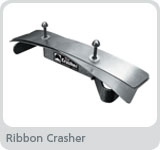
The crasher/crusher was manufactured by the AFRO company, a maker of exotic percussion for a number of years. It usually consists of three strips of metal, spring mounted, and meant to be struck with a drumstick. The sound is a dry metallic “smash” with absolutely no reverberation or ring.
The AFRO company was purchased by Pearl Percussion several years ago and the crasher/crusher was discontinued. HOWEVER:
It is still available. It is now called a RIBBON CRASHER and is made by RhythmTech, a very well known percussion specialist company. If not at your local Rock’n Roll Drum Shop (which is where I first saw it) it can be purchased on line at www.rhythmtech.com. Go to “Products”, into the “Mounted Percussion” and there it is! The Crasher. There are two sizes available. The smaller one is sufficient.
- “ OTSERF 2: Revenge of the Warrior Prince” (2007)
The tempo marking at measure 187 SHOULD read: QUARTER NOTE equals 96 – 104. The tempo marking at measure 217 is correct (HALF NOTE equals 96-104) The Half note at 217 equals previous quarter note. I think that the metronome marking of “96” is actually the best tempo here.
- “GEARS PULLEYS CHAINS” (2005)
Performance suggestions: There are several “invented” instruments listed in the PERCUSSION section of this piece. All the equipment needed to
MAKE these instruments can be found at any full service “home Repair” store like Lowe’s or Home Depot. Here is a photo journal of the percussion needs entitled “Spin Chain on Pipe”, “Nails on Pipe”, and METAL Claves.
- Percussion Stand
Here I have used one of our gong stands to demonstrate. The pipe is a 1-1/4 inch X 36″ galvanized steel pipe. It came already cut to this size.

2. Utility chain
I suspended the pipe from the stand with #1 Double Loop Utility chain. (I bought about four feet, but obviously less would do.) Be sure and hang the pipe with the chain either at a 90 degree angle or wider, so as not to bind the vibration of the pipe. Don’t use chain any larger!

3. Quick Link
The large chain is 3/8″ Proof Coil Chain. It is fairly large chain. I bought a 3 foot length of it and a 5/16″ Quick Link is used to close the loop.
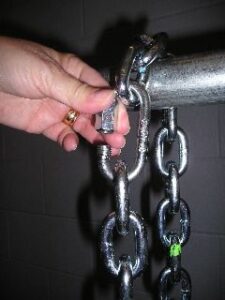
4. Spin chain
When the percussion part says spin the chain, have the percussionist give it a good yank and . . . well, spin the chain.

5. Gutter Nails
When the instructions say, NAILS ON PIPE, use 12″ galvanized Gutter spikes like you see below. And simply strike the pipe.
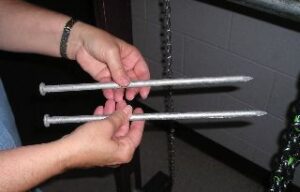
6. Nails on Pipe
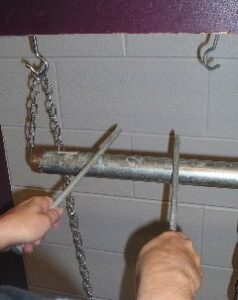
7. Black Pipe Nipples
And LASTLY, the piece calls for metal claves, HOWEVER, these are really expensive. I would suggest that you go to Lowe’s or Home Depot and pick up two 3/8″ X 8″ BLACK steel pipe nipples, like those pictured below. They are ready made and have a wonderful sharp metallic ring to them!
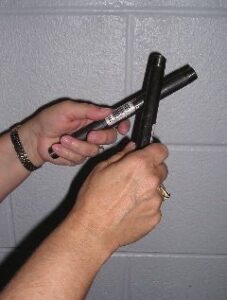
4. “TIL HIS HAND GREW TIRED AND FROZE TO THE SWORD” (2004)
Errata and Performance Suggestion: When I first rehearsed and conducted this work several weeks ago, I found that I liked the opening section better a little faster than Quarter Note equals Circa 60.
There is one GLARING mistake in the score and parts. At Measure 39, the new tempo marking is MISSING! My fault. I simply missed the entry while preparing the score. The tempo marking at Measure 39 should be Quarter Note = circa 160. I would suggest that the “Slightly Faster” at Measure 56 be Quarter Note =Circa 170.
I found that I also jumped the tempo up a notch at Measure 138. It just happens! I went about Quarter = 176.
5. “ADAGIO” (1999) – Performance suggestions:
I usually add these interpretive markings in the first rehearsal:
“Crescendo through the first seven measures – decrescendo, measure eight.
“Add a crescendo in ALL parts measures 9 through 12, leading to 13
“Increase tempo slightly at Number 17.
“F Horns should DOMINATE at Number 34. Mark parts – “forte”
“Add a crescendo in ALL parts measures 59 through 62, leading to 63.
6. “ABOUT THE “HOLSINGER STYLE”
A number of interpretative questions about what I expect my music to “sound” like can be answered by reading a book, COMPOSERS ON COMPOSING FOR BAND, edited by Mark Camphouse, and published by GIA. There are, in fact, eleven composers who have offered chapters in that book, and all the chapters are worth the read!
Each composer was asked to write a definitive section dealing with the “creative process” as they understand it and apply it to their own works.
I know that in one of the sections of my chapter, I talked at length about my expectations of expressive style and how I perceive my scores as both a composer and a conductor.
This is a great reference to utilize if you want to get into the composers “head”! I would recommend this book (and its succeeding volumes) highly.
7. “LITURGICAL DANCES” (1984)
ERRATA: I understand that there are several block chords where both major and minor thirds appear in different parts! Obviously, one of them is wrong. Now, because I do not necessarily follow symmetrical patterns, just because there was a harmonic pattern once, doesn’t mean that I won’t reverse it the next time around. So, how do you decide which is the correct chord? Count the notes. If there are more major thirds than minor thirds, it was probably meant to be a Major chord. Or vice-versa. The following rule applies to most mistakes like that in my music: Majority rules!
That was simple enough.
PROGRAM NOTES: Liturgical Dances was commissioned in 1981 by Beta Mu Chapter of Phi Mu Alpha Sinfonia to honor the chapter’s 75th anniversary at Central Methodist College. Unlike many of Holsinger’s other works, Liturgical Dances is not programmatic, but rather a reflection of the composer’s memories of his student days as a brother in Beta Mu. The music is both poignant and exuberant, “classic” and “modern”, rambunctious and reflective. It pays tribute to Men of Music, not only for their dedication to a vocation, but also for their passion to the medium. The composer’s tribute is probably best summed up in the subtitle, “Benedicamus Socii Domino” – Let us all, as companions, praise the Lord!
8. “ON AN AMERICAN SPIRITUAL” (1991)
ERRATA: If you’ve played this piece even once, you’ve realized almost immediately that the metronome marking of Quarter Note = 126 just doesn’t match up to the prefix “slowly, expressively, rubato”. To this day, no one knows how THAT number got into that parenthesis! (A demon in the printing press has been suggested more than once!) Anyway, the correct tempo is Quarter Note = ca. 80.
There is a missing two measure crescendo marking in the F Horns through measures 25 & 26, leading to m. 27. Horns should have an “sfz” attack at Number 27.
There are wrong pitches written in the F Horn parts at Measure 76. The pitches should be: B-B-A-A, in the first horn and G#-G#-E-E, in the second horn.
- “PRELUDE AND RONDO” (1975)
ERRATA: Speaking of F Horns parts, if you have a very early edition of this work, the last note of the piece for the FIRST HORN
10. “SCOOTIN’ ON HARDROCK” (1999)
Performance suggestions: As a conductor of this work for the past several years, here are a couple of “enhancements” I have made to the musical styling:
At Measure 122 (The second section of the piece) I have all those who play that opening measure, emphasize beat four over all the others. In other words, each measure crescendos to four, backs off, and does it again, and again, etc. Every time that figure or one that alludes to that figure appears, I have the players always make it “lean” toward the fourth beat.
Measure 143: Melody insert a “mf/p” and crescendo for that measure. It”s just a little “bluesy” thing to do.
I have a friend, Tom Leslie at UNLV who does a neat thing with the last section. He will play measures 213, 239, 243, and 268 suddenly soft. Then kick back to forte in the following measures. It’s very effective!
I invariably put a long “big band” FALL on the last note.
11. “ABRAM’S PURSUIT” (1998)
ERRATA: In measures 107, 109, 111, and 113, the third Cornets should have a B-flat in that figure, not a B-natural.
12. “IN PRAISE OF GENTLE PIONEERS” (1996)
Performance suggestions: If I had it to do over, I would mark the opening figures differently, so as to exploit the tension in those clusters. Let me suggest that Measures 1, 2 & 3 crescendo to a “mf ” in Measure 4 and decrescendo. Measures 5, 6, & 7 crescendo to a “mf “ in Measure 8, and then decrescendo. That Measures 13, 14, & 15 crescendo to a “mf ” in Measure 16 and then diminuendo. Measures 21, 22, & 23 crescendo to a “mf ” in Measure 24, and then decrescendo.
Please, no breath between Measures 92 & 93! And don’t rush through the “breath marks” in measures 99 & 101. Let the ensemble “step out of time” for a second at those marks.
13. “ON A HYMNSONG OF PHILIP BLISS” – ALL VERSIONS
Expanded Program Notes: Horatio G. Spafford, a Chicago Presbyterian layman and successful businessman, planned a European trip for his family in 1873. In November of that year, due to unexpected last minute business developments, he had to remain in Chicago; but he sent his wife and four daughters on ahead as scheduled aboard the S.S. Ville du Havre. He expected to follow in a few days. On November 22, the ship was struck by the Lochearn, an English vessel, and sank in twelve minutes. Several days later the survivors were finally landed at Cardiff, Wales, and Mrs. Spafford cabled her husband, “Saved Alone.” Shortly afterward Spafford left by ship to join his bereaved wife.
It is speculated that on the sea near the area where it was thought his four daughters had drowned, Spafford penned this text with words so significantly describing his own personal grief, “When sorrows like sea billows roll . . ” It is noteworthy, however, that Spafford does not dwell on the theme of life’s sorrows and trials, but focuses attention in the third stanza on the redemptive work of Christ. Humanly speaking, it is amazing that one could experience such personal tragedy and sorrow as did Horatio Spafford and still be able to say with such convincing clarity, “It is well with my soul”.”.
Hymn writer Philip Paul Bliss was so impressed with the experience and expression of Safford’s text that he shortly wrote the music for it, first published in 1876. Bliss was a prolific writer of gospel songs throughout his brief lifetime and in most cases, he wrote both the words and the music. This hymn is one of the few exceptions.
There is speculation that this was perhaps the last gospel song written by Bliss. Bliss and his wife, Lucy, were killed in a train wreck in Ashtabula, Ohio, on December 29, 1876. Most sources mention that Bliss actually escaped from the flames at first, but was killed when he went back into the train to try and rescue his wife. Neither body was ever found.
As a postscript, Bliss” trunk was salvaged from the wreckage, and in it, evangelist D. W. Whittle found an unfinished hymn, which began, “I know not what awaits me, God kindly veils my eyes”.
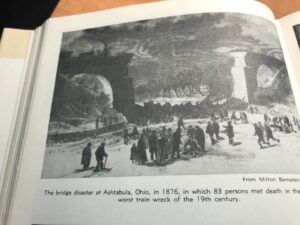
14. “HAVENDANCE “(1983)
Program Notes: David Holsinger’s first child, his daughter Haven, was the inspiration for this 1983 composition. Its driving rhythms represent the energy of an eight year old, who was constantly dancing and twirling around the house, dreaming of being a ballerina. The composition undergoes several variations in style, but it is always filled with energy. Some passages evoke the image of a single dancer, with solo pirouettes and leaps; these light efforts grow to draw in the full dance company with an unrelenting, underlying rhythm. HAVENDANCE is the first of three dancesongs honoring the composer’s children; NILESDANCE and GRAYSONDANCE reflect the diverse personalities of his two sons. (Program notes by David Bruce Adams)
15. ” THE “LION’S ROAR” ” DIVERTIMENTED DANCES” (2007)
The movement entitled “Pixie/Troll/Pixie Dance” calls for another “make it yourself” instrument, the Lion’s Roar. There are a couple of stores that have one “for rent”, but it’s just as easy to make one. It is literally a tenor drum with a small rope tied thru the top head and knotted inside the drum shell. Use a washer to keep the head from tearing at the knot. The player pulls the rope tight and with a RESINED rag tightly grips the rope and pulls outward from the drumhead. (Pine tar on the rag also works well.) The vibration of the rope against the head of the drum creates a GRRRRRRRRRRRR sound . . . hence, the “Lion’s Roar”.

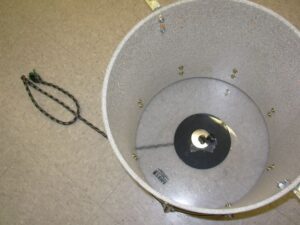
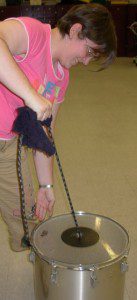
- TRANSLATION OF “HEBREW” SOUNDING WORDS AT THE END OF “IN THE SPRING”.
What do all those “Hebrew-like” words at the end of IN THE SPRING mean? Do they translate into English?
First of all, a bit of Biblical trivia. Scholars usually agree that, for the most part, prayers in the Old Testament were sung. For example, we all are aware that the Psalms are “songs”. And the poems of the Book of Solomon are designated the “Song of Solomon”.
With this in mind, when I set about depicting the first three verses of I Chronicles 20, I imagined that at the end of the great siege and battle, all the armies of David began to sing prayers of thanksgiving for those who lived and prayers of honor for those who died. Therefore, I wrote this section of vocal permutations to portray that belief.
The words – some that I “Hebrew-ized” – are simply nonsense syllables. They have been referred to by many, as resembling the “in the spirit” singing heard in many charismatic congregations. Admittedly, being a full gospel believing Christian, that was, to a certain extent, my intent, aurally.
17. POSSIBLE ERRATA IN EDITION OF “A CHILDHOOD HYMN.”
A recent email from band director, Matthew Palmieri pointed out some errata in his edition of A CHILDHOOD HYMN. Matthew’s message, in part reads: Here are the differences between my score and parts:
•Alto Sax 2: m5, last note of the triplet is an F-sharp in the score, but a G in the part. (Two g’s in a row rather than the descending scale.)
•Baritone: m16, second note is a C in the score, but a B-flat in the part. (Two B-flats in a row rather than the descending scale.)
*Trombone 2: m26, last note is G in the score, but an F in the part.
•Trombone 2: m28, second note is a G-flat in the score but an A-flat in the part.
I have changed the parts to match the score. We’ve found those while rehearsing. I think that is all, but I’ve not made an exhaustive comparison of parts and score. I asked on the band directors face book group, and several people said they had not found any errors, but these are definitely in the parts that we have. I wonder if there might be more than one edition?
You might check this out. I appreciate Matthew’s input.
18. PROGRAM NOTES FOR “HOPAK RASKOLNIKI”
“Hopak Raskolniki”was only my second composition for concert band (circa 1980), but its use of layered lines over fluctuating time signatures and the use of metric modulation near the end of the piece was a vast departure from my first publication and a significant leap (at least for me) in establishing what has become my “style” of composition. For those who seek to find great “spiritual dimension” to the title, I’m afraid I shall have to disappoint you . . . The title actually comes from this composer’s readings of the life of Russian composer, Nicolas Rimsky-Korsakov. In the 1880’s he was instrumental in a movement among Russian composers and musicians to turn from the extreme nationalistic tradition and create a new “style” of music based on broader, more eclectic methods and resources. One account I perused mentioned his artistic struggle with the Council of Old Believers, the “Raskolniki” . . . I was immediately taken with the phrase and this “Russian Dance for the Raskolniki” was born! (I will be quick to admit that my “hopak form” is totally unconventional, completely removed from the original dance form, and used in the title by way of poetic license! This admission hereby excuses my liability to the “closet” Russian Musicology fringe-groups found among band directors far and wide!)
*******
MUSIC AT THE LEE UNIVERSITY SCHOOL OF MUSIC
The Lee University School of Music is dedicated to music education and performance, be it on the church platform or the concert stage. Under the leadership of Dr. William R. Green, Dean of the School of Music, that dedication is easily seen in the rapid growth and national prominence of both its programs and its faculty. The university population is circa 4000 students, with over 300 music majors and nearly 700 students involved in some venue of music performance.
Long known for its dedication to Christian Music, Lee has graduated a number of young people who have gone on to successful recording and ministry careers. The Lee Festival Choir can be heard on the CD entitled “Best Choirs in America” and both Lee Singers and Campus Choir have made appearances on the Inspiration Network and with various artists, including Alvin Slaughter, Ron Kenoly, and Bill Gaither. Recent Lee students reaching national TV and recording prominence include Clark Beckham, Phil Stacey, and Jordan Smith.
Equally important is the Lee vocal commitment to the concert arts. The Opera is also a vital part of the vocal curriculum, and Lee boasts a number of its graduates beginning to fill major concert and opera roles in distinguished companies across the nation. The Department of Vocal Music boasts of eight full time faculty members dedicated to individual study in voice. There are five other vocal faculty members whose main responsibility is the various choirs of the department – Campus Choir, Lee Singers, Evangelistic Singers, Ladies of Lee, and the Voices of Lee.
In addition to degrees in performance and church music, the Lee School of Music is also highly motivated to teacher education.
The Department of Instrumental Music hosts a vast array of ensembles and performing artist teachers. Embraced in the realm of the Instrumental Department, are two concert bands, jazz ensemble, percussion ensemble and a host of chamber opportunities, all directed by outstanding conductors and teachers.
In addition to preparing students for professional life after college graduation, the School of Music also finds value in preparing its students for graduate degrees in music, whether at Lee, or at other distinguished and prestigious schools of music across the nation.
A Christian environment and teams of personally committed professionals are the hallmarks that encompass all programs in Lee’s graduate studies. Lee University’s graduate programs provide an educational experience that meets the most important requirement – a profitable engagement of the student’s time, purpose and personal resources. Four of the fifteen graduate degree programs at Lee reside in the School of Music: The Master of Church Music, the Master of Music – Music Education, the Master of Music – Music Performance, and since the Fall, 2012, a Master of Music in Choral or Wind Conducting.
The Lee University School of Music is an exciting, energetic, imaginative, diverse environment, where praise and worship guitarists, opera singers, instrumental soloists, jazz trap set drummers, music business majors, and young conductors all thrive under the same banner – that Jesus Christ is LORD OF ALL and in His kingdom, a call for excellence knows no boundaries or limitations in our student’s musical pursuits.
LEE UNIVERSITY
ABA OSTWALD PRIZE
http://en.wikipedia.org/wiki/Sousa/Ostwald_Award
http://lib.guides.umd.edu/content.php?pid=187541&sid=2581504
THE EASTER SYMPHONY – ESSAY
http://gustavus.edu/music/winds/gwo/easter.php
********
